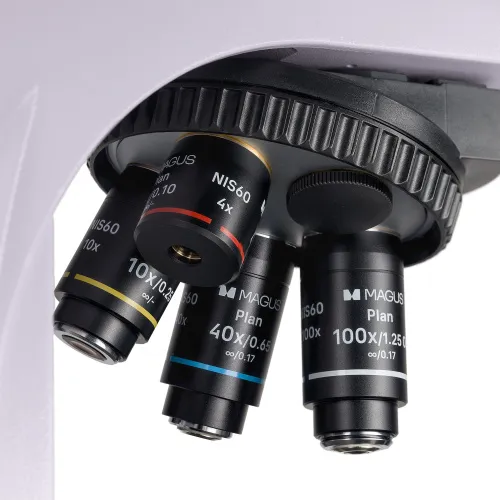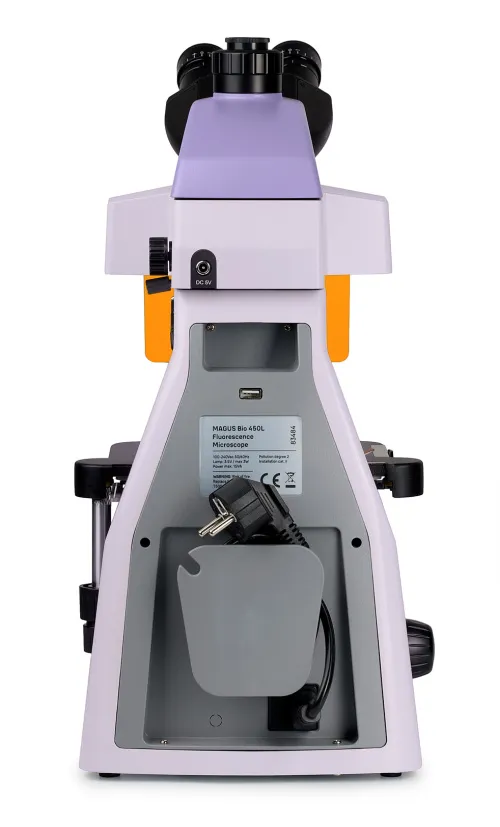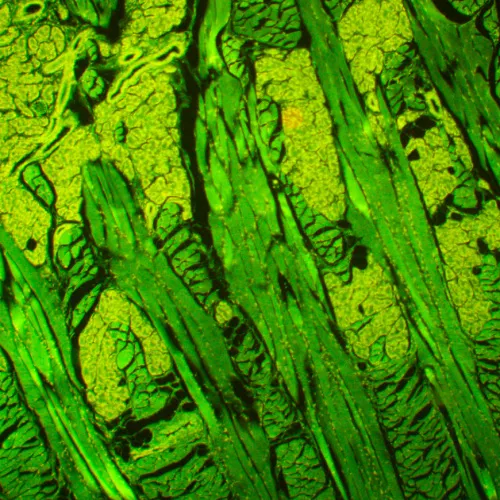MAGUS Lum 450L Fluorescence Microscope
Magnification: 40–1000x. Trinocular head, plan achromatic objectives, reflected and transmitted light sources – 3W LEDs, Köhler illumination in transmitted light
| Product ID | 83484 |
| Brand | MAGUS |
| Warranty | 5 years |
| EAN | 5905555019505 |
| Package size (LxWxH) | 38x67x47 cm |
| Shipping Weight | 14.4 kg |
The MAGUS Lum 450L microscope can be used to conduct research in brightfield and fluorescent light. With additional components, research in the darkfield method, phase contrast, or polarized light can also be conducted. During fluorescence observations, the MAGUS Lum 450L illuminates the sample in blue or green so that the objects produce green-yellow or red light, respectively. Fluorescence microscopes are used in medical examinations, forensic or pharmacological studies as well as veterinary and sanitary control. This model is equipped with a smart illumination system that adjusts the light intensity to the characteristics of the objectives, and an LCD screen on which you can control the operating parameters.
The microscope is equipped with a trinocular head: two eyepiece tubes, and the third one is for a digital camera. Eyepiece tubes are designed for infinity-corrected optics. The user can adjust their height by twisting the tubes 360°. Users with visual impairments have no restrictions in working with this microscope: The model comes with basic 10x/22mm eyepieces with diopter adjustment rings, and the exit pupil on the eyepieces is placed at a sufficient distance to allow working with glasses. The glass lenses and eyepieces are protected by flat rubber eyecups. When connecting a camera, the light beam in the microscope is split 50/50.
The revolving nosepiece has 5 slots for installing objectives. The parfocal distance is 60mm. The revolver is directed away from the observer, which leaves free space above the object stage for manipulation. The microscope set includes 4 objectives from 4 to 10x. You can install an additional objective in the free slot to expand the magnification range. The special feature of the revolver is its part of the “smart” lighting system. The user adjusts the light intensity to the magnification of each objective once, and then when turning the nosepiece, the light is set to the desired intensity automatically. Thanks to this, there are no sharp changes in the level of illumination in the eyepieces, the user’s eyes get less tired, and there is no need to waste time constantly adjusting the brightness of the light.
The object stage has an ergonomic design: The specimen is moved using a belt drive mechanism, there is no positioning rack, and the stage is controlled with a long handle. All the while, the user can keep their hands on the table without strain. The stage is equipped with a specimen holder secured with two screws and can be easily removed.
Focusing is performed using coaxial knobs on the stand: On the left, there is a coarse focusing knob, and fine adjustment is made by the knobs on the right and left sides. Another handle is used to lock coarse focusing. The travel tension is adjusted using a ring.
Lighting in the microscope is provided by 3W LEDs: a transmitted light illuminator works for brightfield studies, and a reflected light illuminator is used for fluorescence studies. To create a fluorescent glow, the set contains two filters, blue and green. They change when you turn the switch on the fluorescent attachment left or right. If the switch is centered, the microscope is ready for work in the brightfield method. The LEDs are designed for 50,000 hours of operation. They do not take time to reach the required intensity, do not change temperature, and turn off immediately.
The microscope allows you to adjust Köhler illumination, which is used for various research methods. It forms a high-quality image without traces of artifacts, the sample and the entire field of view are illuminated with even light without darkening at the edges.
The adjustable iris diaphragm condenser is height adjustable and centered. The connection to the microscope is made using a dovetail mount. For the ease of adjustment, there are marks on the body of the condenser corresponding to the magnification indicators of the objectives, and on its ring, there is a pointer. To achieve a contrast image, set the mark to the desired magnification. The condenser has a slot for installing darkfield or phase contrast sliders. When working using other methods, the slot is closed with a plug.
All of the selected parameters – the working objective magnification, lighting settings, and the current operating mode – can be monitored on the built-in LCD screen. By controlling the relevant knob, the user can set their desired sleep mode as well as set the timer to turn off, adjust the brightness, or set it to lock.
The design of the microscope is aimed at maximum user convenience. In addition to the features already described, it has a carrying handle, and the power cord is hidden from view, which is not only esthetically pleasing but also safe.
The microscope can be supplemented with various accessories to expand its functionality: Eyepieces will add magnification, and optional components will allow you to conduct research using other methods. A calibration slide, in combination with eyepieces with a scale or with a digital camera, will help you measure an object.
Key features:
- Research can be carried out both in brightfield and fluorescence light
- Darkfield, phase contrast, or polarized light studies are available with optional components
- To work under fluorescence light, the sample is illuminated with blue or green light and produces a yellow-green or red
- Smart lighting system automatically adjusts light brightness when switching objectives
- LCD screen displays the selected operating parameters
- Trinocular head, the position of the eyepiece tubes is adjusted to the user’s height
- The condenser is marked for objectives magnification for ease of adjustment
- Köhler illumination
The kit includes:
- Stand with built-in power supply, reflected visible light illuminator, transmitted light source, focusing mechanism, stage, condenser mount, and revolving nosepiece
- CMO system
- Reflected light illuminator
- Trinocular head
- Plan achromatic infinity-corrected objective: 4x/0.10, parfocal height 60mm
- Plan achromatic infinity-corrected objective: 10x/0.25, parfocal height 60mm
- Plan achromatic infinity-corrected objective: 40x/0.65 (spring-loaded), parfocal height 60mm
- Plan achromatic infinity-corrected objective: 100x/0.25 oil (spring-loaded), parfocal height 60mm
- Eyepiece 10x/22mm with long eye relief and diopter adjustment (2 pcs.)
- Eyepiece eyecup (2 pcs.)
- Light filter
- C-mount camera adapter
- Bottle of immersion oil
- AC power cord
- Dust cover
- User manual and warranty card
Available on request:
- 10x/22mm eyepiece with scale
- 10x/22mm eyepiece with reticle
- 10x/22mm eyepiece with crosshairs
- 12.5x/17.5mm eyepiece (2 pcs.)
- 15x/16mm eyepiece (2 pcs.)
- 20x/12mm eyepiece (2 pcs.)
- Plan achromatic infinity-corrected objective: 20x/0.40, parfocal height 60mm
- Phase contrast device: set of phase sliders, auxiliary centering telescope, set of phase objectives
- Darkfield slider
- Polarization device
- Digital camera
- Calibration slide
- Monitor
| Product ID | 83484 |
| Brand | MAGUS |
| Warranty | 5 years |
| EAN | 5905555019505 |
| Package size (LxWxH) | 38x67x47 cm |
| Shipping Weight | 14.4 kg |
| Type | biological, light/optical |
| Microscope head type | trinocular |
| Head | Gemel head (Siedentopf, 360° rotation), with 50/50 distribution of the luminous flux |
| Head inclination angle | 30 ° |
| Magnification, x | 40 — 1000 |
| Magnification, x (optional) | 40–1250/1500/2000 |
| Eyepiece tube diameter, mm | 30 |
| Eyepieces | 10x/22, long eye relief (*optional: 10x/22 with scale, 10x/22 with reticle, 10x/22 with crosshair, 12.5x/17.5, 15x/16, 20x/12) |
| Objectives | infinity plan achromatic: 4x/0.10; 10x/0.25; 40xs/0.65; 100xs/1.25 oil (*optional: 20x/0.40); parfocal distance: 60mm |
| Revolving nosepiece | 5 objectives, coded |
| Working distance, mm | 30 (4x); 10.2 (10x); 1.5 (40xs); 0.2 (100xs) |
| Interpupillary distance, mm | 47 — 78 |
| Stage, mm | 230x150 |
| Stage moving range, mm | 78/54 |
| Stage features | two-axis mechanical stage, without a positioning rack |
| Eyepiece diopter adjustment, diopters | ±5D on each eyepiece |
| Eyepiece diopter adjustment | ✓ |
| Condenser | center- and height-adjustable Abbe condenser NA 1.25 with adjustable aperture diaphragm and slot with plug for darkfield and phase contrast sliders; dovetail mount |
| Diaphragm | adjustable aperture diaphragm, adjustable iris field diaphragm |
| Focus | coaxial, coarse (30mm, 37.7mm/circle, with a lock knob and tension adjusting knob) and fine (0.002mm, 0.2mm/circle) |
| Illumination | LED |
| Brightness adjustment | ✓ |
| Power supply | 100–240V, 50/60Hz, AC network |
| Light source type | reflected and transmitted light: 3W LED |
| Light filters | yes |
| Operating temperature range, °C | 0...+70 |
| Additional | automatic brightness adjustment when switching objectives, eco mode, sleep mode, status display on LCD screen |
| Ability to connect additional equipment | darkfield slider, phase contrast device (slider and objectives), polarization devices (polarizer and analyzer) |
| User level | experienced users, professionals |
| Assembly and installation difficulty level | complicated |
| Fluorescent module | blue (B), 460–495nm/505nm/510nm; green (G), 510–550nm/570nm/575nm |
| Application | laboratory/medical |
| Illumination location | dual |
| Research method | bright field, fluorescence |
| Pouch/case/bag in set | dust cover |
We have gathered answers to the most frequently asked questions to help you sort things out
Find out why studying eyes under a microscope is entertaining; how insects’ and arachnids’ eyes differ and what the best way is to observe such an interesting specimen
Read this review to learn how to observe human hair, what different hair looks like under a microscope and what magnification is required for observations
Learn what a numerical aperture is and how to choose a suitable objective lens for your microscope here
Learn what a spider looks like under microscope, when the best time is to take photos of it, how to study it properly at magnification and more interesting facts about observing insects and arachnids
This review for beginner explorers of the micro world introduces you to the optical, illuminating and mechanical parts of a microscope and their functions
Short article about Paramecium caudatum - a microorganism that is interesting to observe through any microscope


























